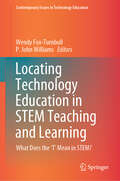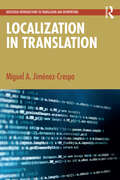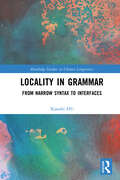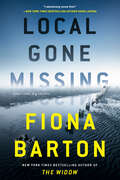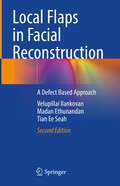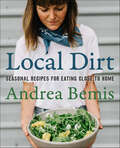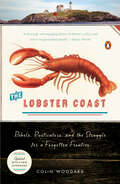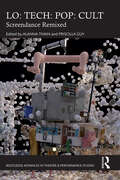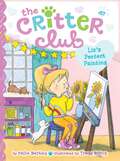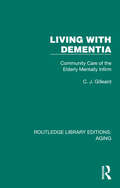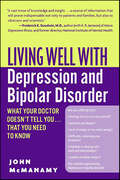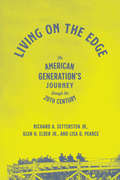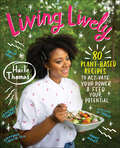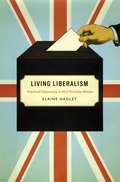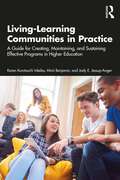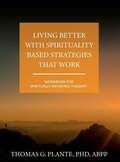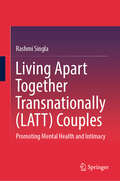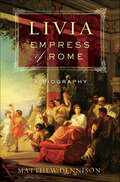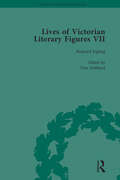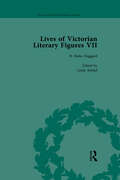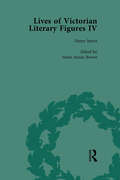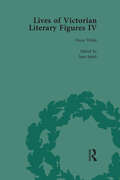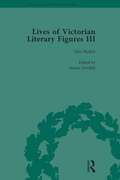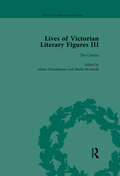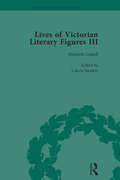- Table View
- List View
Locating Technology Education in STEM Teaching and Learning: What Does the ‘T’ Mean in STEM? (Contemporary Issues in Technology Education)
by Wendy Fox-Turnbull P. John WilliamsThis book offers clarity and consistency of thinking in relation to Technology Education when situated within a STEM approach to teaching. It examines the range of Innovations and Issues which are being considered by schools as they implement STEM, with particular focus on the place of Technology, or the ‘T’ in STEM. The book is divided into three sections: Philosophy, Implementation and Issues and Innovations, with each containing five to seven chapters. The first section lays the foundations for the remainder of the book: it focuses the readers on the technology aspect of STEM education and situates it to align with the international understanding of technology education. The second section provides insights into how STEM is best implemented to give technology due consideration across a range of disciplines with technology education, including engineering, food technology, and textile technology. This section also provides suggestions for the successful implementation of the STEM approach, and offers further insight through a range of case studies. The third section outlines and discusses a range of issues that pose a threat to the position and understanding of technology within the STEM teaching and learning approach. This section also examines how technology and STEM are situated within, are supported or are threatened by, other current innovations and approaches to teaching an integrated curriculum, such as the Maker Space Movement and Play-based Learning.
Localization in Translation (Routledge Introductions to Translation and Interpreting)
by Miguel A. Jiménez-CrespoLocalization is everywhere in our digital world, from apps to websites or games. Our interconnected digital world functions in part thanks to invisible localization processes that allow global users to engage with all sorts of digital content and products. This textbook presents a comprehensive overview of the main theoretical, practical, and methodological issues related to localization, the technological, textual, communicative, and cognitive process by which interactive digital texts are prepared to be used in contexts other than those of production.Localization in Translation provides an interdisciplinary introduction to the main practical and theoretical issues involved in localizing software, web, video games, and apps. It discusses the many technological, cultural, linguistic, quality, economic, accessibility, and user-reception issues related to the different localization types. It also provides an updated overview of localization in an ever-changing technological landscape marked by advances in neural machine translation and AI. Each chapter includes a basic summary, key questions, a final section with discussion and assignments, as well as additional readings. Online resources with additional questions and assignments are included on the Routledge Translation Studies portal.This is the essential textbook for advanced undergraduates and graduates in translation studies and translation professionals engaged in localization practice.
Locality in Grammar: From Narrow Syntax to Interfaces (Routledge Studies in Chinese Linguistics)
by Xiaoshi HuLocality in Grammar: From Narrow Syntax to Interfaces investigates the operation of locality conditions in syntax and semantics from a cross-linguistic perspective.It is claimed that there are two different types of locality conditions. One is the Generalized Minimality Condition (GMC), and the other is the Phase Impenetrability Condition (PIC). This book demonstrates that these locality conditions play different roles in different computational components of human language, and, therefore, cannot be unified as one constraint as proposed in the literature.The main idea of the book is that the two different locality conditions are sensitive to the difference between syntactic derivation and semantic interpretation and that of overt and covert syntactic derivations. Further investigation shows a more fine-grained distinction must be made between syntactic computations. It is true that GMC does not constrain overt syntactic derivations and PIC does not play a role in semantic interpretations; however, they both regulate covert syntactic computations.This book will inform postgraduate students and scholars in the field of linguistics.
Local Gone Missing
by Fiona BartonINSTANT NATIONAL BESTSELLERDetective Elise King investigates a man&’s disappearance in a seaside town where the locals and weekenders are at odds with each other in this suspenseful new novel from the #1 bestselling author of The Widow.Elise King is a successful and ambitious detective—or she was before a medical leave left her unsure if she'd ever return to work. She now spends most days watching the growing tensions in her small seaside town of Ebbing—the weekenders renovating old bungalows into luxury homes, and the locals resentful of the changes. Elise can only guess what really happens behind closed doors. But Dee Eastwood, her house cleaner, often knows. She&’s an invisible presence in many of the houses in town, but she sees and hears everything. The conflicts boil over when a newcomer wants to put the town on the map with a giant music festival, and two teenagers overdose on drugs. When a man disappears the first night of the festival, Elise is drawn back into her detective work and starts digging for answers. Ebbing is a small town, but it's full of secrets and hidden connections that run deeper and darker than Elise could have ever imagined.
Local Flaps in Facial Reconstruction: A Defect Based Approach
by Velupillai Ilankovan Madan Ethunandan Tian Ee SeahWritten by three consultants with extensive skin cancer experience and international reputations for excellence, this book provides comprehensive practical solutions for defects in the head and neck region that clinicians are confronted with in day-to-day practice. The first edition of the “local flaps in facial reconstruction- a defect base approach” was published nearly four years ago and has since been well received around the world and translated into other languages. This second edition is intended to facilitate the decision-making process and provide practical,step-by-step guidance on reconstructing specific defects in the facial region.The frequency of skin cancer continues to rise around the globe, and clinicians with various backgrounds are involved in the care of these patients. In this book, new procedures are described and “old” ones re-evaluated. The current edition has been extensively updated with new text and diagrams so as to provide comprehensive practical solutions for frequently encountered facial defects. Color diagrams and clinical photographs have been included where necessary to provide additional details. The original ethos of creating a text that can be used in everyday practice, while also including personal comments, is maintained.Given the scope, the book is ideal for use by clinicians and trainees in daily practice, and will help to achieve excellent cosmetic outcomes in this aesthetically sensitive part of the body.
Local Dirt: Seasonal Recipes for Eating Close to Home (Farm-to-Table Cookbooks #2)
by Andrea BemisThe author of the popular farm-to-table cookbook Dishing Up the Dirt returns with a dazzling collection of inventive recipes using farm-fresh ingredients, inspired by her commitment to supporting the local food movement.For Andrea Bemis, eating locally is a way of life. After all, her and her husband own and operate an organic vegetable farm in the Pacific Northwest, and the produce they grow—from kale and kohlrabi to beets and butternut squash—is at the heart of the meals they serve and eat at their dinner table. They supplement their harvest with food produced by their neighbors, including the ranchers who supply their meat, and the orchardists who provide their fruit.Andrea has always identified as a sustainable eater—until one day, when she opened a can of coconut milk and realized she had no idea where it came from. This propelled her to look more closely at her pantry, taking stock of the other ingredients that may have traveled some distance. Considering the energy used to transport the avocados, olive oil, and lemons to her Northern Oregon kitchen, she came up with an idea—a 30-day challenge to cook and eat only local food grown from local dirt, using ingredients produced within 200 miles of her home.In Local Dirt, Andrea shares her journey through stories, photographs, and more than 80 recipes, re-creating a not-so-distant world when the ingredients cooked and eaten were produced within local communities. Organized by season, the delicious and creative dishes in this truly sustainable cookbook includes Fennel Gratin, Kohlrabi Yogurt Salad with Smoked Salmon, Winter Squash Toast with Honey & Hazelnuts, and Zucchini Swiss Chard & Chickpea Stew. Best of all, the recipes can be adapted to utilize any local fare. Ultimately, Andrea found that the “challenge” she set out for herself wasn’t a challenge at all, but an opportunity to go back to basics, slow down, and connect even more deeply with her community. In Local Dirt, she offers the inspiration, instruction, and advice we need to eat deliciously and sustainably.
The Lobster Coast: Rebels, Rusticators, and the Struggle for a Forgotten Frontier
by Colin Woodard&“A thorough and engaging history of Maine&’s rocky coast and its tough-minded people.&”—Boston Herald&“[A] well-researched and well-written cultural and ecological history of stubborn perseverance.&”—USA TodayFor more than four hundred years the people of coastal Maine have clung to their rocky, wind-swept lands, resisting outsiders&’ attempts to control them while harvesting the astonishing bounty of the Gulf of Maine. Today&’s independent, self-sufficient lobstermen belong to the communities imbued with a European sense of ties between land and people, but threatened by the forces of homogenization spreading up the eastern seaboard.In the tradition of William Warner&’s Beautiful Swimmers, veteran journalist Colin Woodard (author of American Character: A History of the Epic Struggle Between Individual Liberty and the Common Good) traces the history of the rugged fishing communities that dot the coast of Maine and the prized crustacean that has long provided their livelihood. Through forgotten wars and rebellions, and with a deep tradition of resistance to interference by people &“from away,&” Maine&’s lobstermen have defended an earlier vision of America while defying the &“tragedy of the commons&”—the notion that people always overexploit their shared property. Instead, these icons of American individualism represent a rare example of true communal values and collaboration through grit, courage, and hard-won wisdom.
LO: Screendance Remixed (ISSN)
by Alanna Thain Priscilla GuyThis edited collection assembles international perspectives from artists, academics, and curators in the field to bring the insights of screendance theory and practice back into conversations with critical methods, at the intersections of popular culture, low-tech media practices, dance, and movement studies, and the minoritarian perspectives of feminism, queer theory, critical race studies and more.This book represents new vectors in screendance studies, featuring contributions by both artists and theoreticians, some of the most established voices in the field as well as the next generation of emerging scholars, artists, and curators. It builds on the foundational cartographies of screendance studies that attempted to sketch out what was particular to this practice. Sampling and reworking established forms of inquiry, artistic practice and spectatorial habits, and suspending and reorienting gestures into minoritarian forms, these conversations consider the affordances of screendance for reimaging the relations of bodies, technologies, and media today.This collection will be of great interest to students and scholars in dance studies, performance studies, cinema and media studies, feminist studies, and cultural studies.
Liz's Perfect Painting (The Critter Club #27)
by Callie BarkleyIn the twenty-seventh book of the Critter Club series, Liz tries to create the perfect painting for an upcoming art show, but the ferret she&’s pet-sitting has other plans!Liz is having an exciting week! The Critter Club is pet-sitting a ferret, and a local artist is looking for artwork from young painters to include in a show. Liz has her heart set on creating the most perfect painting ever. She just needs to make art while pet-sitting. What could go wrong? With easy-to-read language and illustrations on almost every page, The Critter Club chapter books are perfect for beginning readers.
Living with Dementia: Community Care of the Elderly Mentally Infirm (Routledge Library Editions: Aging)
by C. J. GilleardIn the early 1980s, it had only recently been appreciated that what was known of the epidemiology of dementia in the elderly living in the community was just the tip of a large iceberg. Originally published in 1984, reissued here with a new preface, this book is concerned with presenting information on the nature of dementia, its prevalence and the existing pattern of services available at the time. It begins by considering the nature and epidemiology of dementia and examines the problems of supporting dementia sufferers for both families and professionals. Current services in the community are shown to be inadequate, and the division between hospital and community largely inappropriate. In conclusion the author proposes that radical changes to current service provision are necessary including the development of special day centres and residential units for dementia sufferers. Living with Dementia: Community Care of the Elderly Mentally Infirm addressed a topic of major importance and was an invaluable source of information for community nurses, psychiatrists, psychologists, geriatricians, general practitioners and social workers, all of whom encountered the problem. Today we can look back and reflect on what has changed.
Living Well with Depression and Bipolar Disorder: What Your Doctor Doesn't Tell You . . . That You Need to Know
by John McManamySeven years ago, John McManamy was diagnosed with bipolar disorder. Through his successful Web site and newsletter, he has turned his struggles into a lifelong dedication to helping others battling depression and bipolar disorder reclaim their lives. In Living Well with Depression and Bipolar Disorder, he brilliantly blends the knowledge of leading expert authorities with the experiences of his fellow patients, as well as his own, and offers extensive information on:Diagnosing the problemAssociated illnesses and symptomsTreatments, lifestyle, and copingThe effects of depression and bipolar disorder on relationships and sexWith a compassionate and eloquent voice, McManamy describes his belief that depression is a wide spectrum that reaches from occasional bouts of depression to full-fledged bipolar disorder. The first book to help patients recognize this diversity of the disorder, Living Well with Depression and Bipolar Disorder will help sufferers begin to reclaim their lives.
Living on the Edge: An American Generation’s Journey through the 20th Century
by Richard A. Settersten Jr. Glen H. Elder Lisa D. PearceHistory carves its imprint on human lives for generations after. When we think of the radical changes that transformed America during the twentieth century, our minds most often snap to the fifties and sixties: the Civil Rights Movement, changing gender roles, and new economic opportunities all point to a decisive turning point. But these were not the only changes that shaped our world, and in Living on the Edge, we learn that rapid social change and uncertainty also defined the lives of Americans born at the turn of the twentieth century. The changes they cultivated and witnessed affect our world as we understand it today. Drawing from the iconic longitudinal Berkeley Guidance Study, Living on the Edge reveals the hopes, struggles, and daily lives of the 1900 generation. Most surprising is how relevant and relatable the lives and experiences of this generation are today, despite the gap of a century. From the reorganization of marriage and family roles and relationships to strategies for adapting to a dramatically changing economy, the challenges faced by this earlier generation echo our own time. Living on the Edge offers an intimate glimpse into not just the history of our country, but the feelings, dreams, and fears of a generation remarkably kindred to the present day.
Living Lively: 80 Plant-Based Recipes to Activate Your Power and Feed Your Potential
by Haile ThomasNominee, NAACP Image Award for Outstanding Literary Work“Thomas's body positive, social and economic justice-oriented ethos, rich writing, beautiful photography, and accessible recipes are perfect for anyone looking for an antidote to the typical vegan evangelism that often shames people for their food choices.” - ShondalandBy a superstar nineteen-year-old activist and motivational speaker, a unique cookbook and inspiring guide that combines 80 delicious, wholesome, super-powered plant-based recipes with a "7 points of power" manifesto to inspire the next generation of leaders toward self-reflection, critical thinking, and unlearning toxic ideas. When her father developed Type 2 diabetes, eight-year-old Haile Thomas began a journey that would change her family's dietary habits, improve her dad's health, and radically transform her life. Haile’s family began looking into ways to improve his condition without having to rely on medication with dangerous potential side effects. Inspired by her mom’s research, and fueled by her love of food, Haile learned everything she could about nutrition. After seeing how dramatically she and her family were able to change her dad’s health, she chose to expand her reach to make the biggest positive impact possible in the world—particularly in underserved and at-risk communities. At 16, she was the youngest to graduate from the Institute for Integrative Nutrition as a Certified Integrative Nutrition Health Coach. Now a social entrepreneur, speaker, and activist Haile is an advocate for conscious living who promotes resilience, positivity, and a healthy, nourishing lifestyle to young people everywhere.Haile believes that to productively work toward our best selves, we must first fuel the vessel that supports us—our bodies. By incorporating healthy, plant-based dishes into our daily routine, we can boost qualities such as confidence, happiness, and positivity, giving us the energy we need to change our lives and the world.Haile’s delicious, nutrition-packed vegan recipes boost brain power, calm the body, and provide energy. Some of the sensational food in Living Lively includes:Golden Dream Turmeric Berry Chia PuddingFruity Jamaican Cornmeal PorridgePotachos (Potato Nachos) with Green Chile Cheese SauceStraight Fire Mac N' CheeseKorean Jackfruit Sloppy JillAB & J Swirl BrowniesShortcut Sweet Potato Pie BoatsLiving Lively combines these recipes with advice and insights from Haile's life as well as other dynamic, relatable young women, Gen Z leaders who are activating their power every day, including environmentalist and animal rights activist Hannah Testa, dancer and actress Nia Sioux, entrepreneur and mentor Gabrielle Jordan, global activist and sustainable fashion entrepreneur Maya Penn, and self-love advocate Luisa Gaffga. They promote not just physical nutrition but mental and emotional engagement, by paying close attention to the messages we receive from society, our personal relationships, and more to think critically about how they affect us and our outlook on the world.These tools are specifically targeted at positive resistance, growth, and joy in what Haile calls the “7 Points of Power”—wellness, world perspective, media and societal influences, thoughts and spirituality, education, relationships, and creativity and giving. Beautiful and uplifting, Living Lively empowers us to take strong, positive steps to nourish ourselves, each other, our communities, and the planet.
Living Liberalism: Practical Citizenship in Mid-Victorian Britain
by Elaine HadleyIn the mid-Victorian era, liberalism was a practical politics: it had a party, it informed legislation, and it had adherents who identified with and expressed it as opinion. It was also the first British political movement to depend more on people than property, and on opinion rather than interest. But how would these subjects of liberal politics actually live liberalism?To answer this question, Elaine Hadley focuses on the key concept of individuation—how it is embodied in politics and daily life and how it is expressed through opinion, discussion and sincerity. These are concerns that have been absent from commentary on the liberal subject. Living Liberalism argues that the properties of liberalism—citizenship, the vote, the candidate, and reform, among others—were developed in response to a chaotic and antagonistic world. In exploring how political liberalism imagined its impact on Victorian society, Hadley reveals an entirely new and unexpected prehistory of our modern liberal politics. A major revisionist account that alters our sense of the trajectory of liberalism, Living Liberalism revises our understanding of the presumption of the liberal subject.
Living-Learning Communities in Practice: A Guide for Creating, Maintaining, and Sustaining Effective Programs in Higher Education
by Karen Kurotsuchi Inkelas Mimi Benjamin Jody E. Jessup-AngerThis book offers a roadmap for developing, growing, and sustaining living-learning communities (LLCs) that promote student success and enhance the undergraduate experience.Drawing on the Best Practices Model presented in Living-Learning Communities That Work, as well as updated research and rich, real-life examples from LLC administrators, the authors offer a revised and improved model for effective LLC practice. Nuanced typologies guide stakeholders in developing and growing their own programs, from the foundational, to the intermediate, and to the advanced level. This text features an extended section on the assessment of LLCs, complete with a logic model for integrating program assessment with student learning outcomes, and concludes with lessons learned from the COVID-19 pandemic and a look into the future of LLCs in higher education.At a time when colleges and universities struggle to create community for students, this book will be a valuable resource to practitioners, researchers, and institutional leaders to more effectively allocate resources to create and sustain LLCs and to realize the potential of these communities to improve undergraduate education.For more information about ACUHO-I membership, events, and resources, please visit acuho-i.org.
Living Better With Spirituality Based Strategies That Work: Workbook For Spiritually Informed Therapy
by Thomas G. PlanteLiving Better with Spirituality Based Strategies that Work: Workbook for Spiritually Informed Therapy is designed to serve as a practical workbook or companion book to Spiritually Informed Therapy that can be used by therapists with their clients, faculty with their students, or with the general public to put key evidence-based principles into actual practice. The workbook features numerous exercises and practical strategies that can help readers examine and implement core tenets from Jesuit spirituality into their everyday and contemporary life. The core tenets from Jesuit spirituality introduced throughout the book include seeing God (or the sacred) in all things, treating the whole person, using a pathway for decision-making focusing on discernment, ending the day with a five-step reflection, managing conflicts with accommodation, humility, the expectation for goodness, and more. The text features real-world case studies that demonstrate how Jesuit spirituality has helped individuals work through their challenges and discover greater overall wellness. Living Better with Spirituality Based Strategies that Work is an innovative workbook that can be paired with Thomas G. Plante's textbook, Spiritually Informed Therapy, or can be used independently by individuals interested in learning how faith-based principles can enrich their life and experiences.
Living Apart Together Transnationally (LATT) Couples: Promoting Mental Health and Intimacy
by Rashmi SinglaThis book provides deep insight into intimacy and distance in the complex, globalised world through the newly coined concept of couples living apart together transnationally (LATT). Based on a review of the past four decades’ seminal studies and narratives from a qualitative empirical study, including both heterosexual and same-sex couples, it shows intimacy can be maintained without geographical proximity. The book has a rich, layered, and nuanced exploration of LATT couples' experiences of relationship maintenance across distance and time through diverse ways, such as digital emotions, online sexual activity, and meaning–making through spirituality, which challenge existing Eurocentric conceptualisations of intimacy and relationships. It also reveals an array of “good practices” for relationship maintenance across countries, which can inspire other couples and practitioners. Thus, the book is an important resource, not only for academics in the disciplines of psychology, anthropology, cultural studies, family science, sociology, migration, and communication but particularly useful for practitioners dealing with couple relationships, such as counselors, social workers, and mental health advisors. It is also relevant for international organizations and multinational corporations working with couples living apart together transnationally.“The implications of this book for ‘how we live now’ are clear – in a more closely connected and mobile world, the possibility of living our most intimate relationships across distance will affect increasing numbers of us… the book’s informative, theoretical, and practical messages have valuable lessons for many of us now and in the future.”Dr Lucy Williams,University of Kent, the UK· “Living Apart Together Transnationally (LATT) Couples: Promoting mental health and intimacy” gives us insights into the everyday lives of couples living apart together (LAT) in a contemporary world characterized by globalisation, and pandemics that have affected border controls and migration policies in different countries. Rashmi Singla invites us to challenge the way we understand intimate relationships that are connected to physical proximity and provides us with innovative ways to maintain emotional and physical intimacy despite geographical separation. Sayaka Osanami TörngrenAssociate Professor of International Migration and Ethnic Relations, Malmö University, SwedenDr. Rashmi Singla’s book “Living Apart Together Transnationally” addresses a very important problem many modern couples encounter living apart in different countries. The increasing globalization of the job market and mass migration in the past four decades have made this topic more important than ever before. However, research about love and life in such conditions is still limited. The research presented in this book reveals some new qualitative research findings about how partners maintain health and intimacy in such challenging conditions. This book presents novel and invaluable research for scholars in the area of love and couple relationships. Victor Karandashev, Ph. D.,Professor of Aquinas College, Michigan, The U.S.A.Dr. Rashmi Singla's work, 'Living Apart Together Transnationally (LATT),' stands as a profoundly empirical exploration of long-distance couples spanning international borders. The book provides captivating revelations into the lives, intimacies, and spiritual dimensions of such relationships. Offering an interdisciplinary approach, it establishes a robust groundwork for further investigations in this emerging field. Lise Paulsen Galal, PhD, Associate Professor in Intercultural Studies, Roskilde University, Denmark.How important is proximity in intimate relationships when partners live apart in different countries? This question sits at the core of this timely book, which offers new insights, in part
Livia, Empress of Rome: A Biography
by Matthew DennisonRome is a subject of endless fascination, and in this new biography of the infamous Empress Livia, Matthew Dennison brings to life a woman long believed to be one of the most feared villainesses of history.Second wife of the emperor Augustus, mother of his successor Tiberius, grandmother of Claudius and great grandmother of Caligula, the empress Livia lived close to the center of Roman political power for eight turbulent decades. Her life spanned the years of Rome's transformation from Republic to Empire, and witnessed both its triumphs under the rule of Augustus and its lapse into instability under his dysfunctional successor.Livia was given the honorific title Augusta in her husband's will, and was posthumously deified by the emperor Claudius—but posterity would prove less respectful. The Roman historian Tacitus anathematized her as "malevolent" and a "feminine bully" and inspired Robert Graves's celebrated twentieth-century depiction of Livia in I, Claudius as the quintessence of the scheming matriarch, poisoning her relatives one by one to smooth her son's path to the imperial throne.Livia, Empress of Rome rescues the historical Livia from the crude caricature of popular myth to paint an elegant and richly textured portrait. In this rigorously researched biography, Dennison weighs the evidence found in contemporary sources to present a more nuanced assessment. Livia's true "crime," he reveals, was not murder but the exercise of power. The Livia who emerges here is a complex, courageous and gifted woman, and one of the most fascinating and perplexing figures of the ancient world.
Lives of Victorian Literary Figures, Part VII, Volume 3: Joseph Conrad, Henry Rider Haggard and Rudyard Kipling by their Contemporaries
by Ralph Pite Keith Carabine Tom Hubbard Lindy StiebelThis book is a collection of biographical records portraying the life of Rudyard Kipling, drawn from official biographies, memoirs, testimonies, letters, diaries, conversations, anecdotes, essays, and reviews.
Lives of Victorian Literary Figures, Part VII, Volume 2: Joseph Conrad, Henry Rider Haggard and Rudyard Kipling by their Contemporaries
by Ralph Pite Keith Carabine Tom Hubbard Lindy StiebelThis book looks at Rider Haggard from a different standpoint, his own. It carries a selection of critical appraisals of Haggard's work by his contemporaries up until the early 1950s.
Lives of Victorian Literary Figures, Part IV, Volume 2: Henry James, Edith Wharton and Oscar Wilde by their Contemporaries
by Ralph Pite Elizabeth Nolan Janet Beer Sarah Annes Jane SpiritPart of the "Lives of Victorian Literary Figures" series, this set collects contemporary memoirs, biographies and ephemera relating to Oscar Wilde, Henry James and Edith Wharton. Editorial apparatus includes a general introduction, headnotes, endnotes and a general index.
Lives of Victorian Literary Figures, Part IV, Volume 1: Henry James, Edith Wharton and Oscar Wilde by their Contemporaries
by Ralph Pite Janet Beer Sarah Annes Brown Jane Spirit Elizabeth NolanPart of the "Lives of Victorian Literary Figures" series, this set collects contemporary memoirs, biographies and ephemera relating to Oscar Wilde, Henry James and Edith Wharton. Editorial apparatus includes a general introduction, headnotes, endnotes and a general index.
Lives of Victorian Literary Figures, Part III, Volume 3: Elizabeth Gaskell, the Carlyles and John Ruskin
by Ralph Pite Aileen Christianson Simon Grimble Sheila A Mcintosh John MullanRuskin grew up in suburban London; in later life, he settled in the Lake District. Thomas and Jane Welsh Carlyle moved from rural Scotland to London's Cheyne Walk. This title focuses on writers for whom 'the centre' was a pressing concern. Elizabeth Gaskell, like her contemporary Emily Bronte, was from the north of England, though based in Lancashire and Cheshire rather than Yorkshire. Her first novel, Mary Barton 1848) was set in the north and was unusually realistic in its depiction of Manchester working-class life.. The three volumes that comprise a set are facsimile reproductions of contemporary biographical material. They include letters, memoirs, poems and articles on three outstanding Victorian literary persons: John Ruskin, Elzabeth Gaskell and the Carlyles.
Lives of Victorian Literary Figures, Part III, Volume 2: Elizabeth Gaskell, the Carlyles and John Ruskin
by Ralph Pite Valerie Sanders Aileen Christianson Simon Grimble Sheila A McintoshThomas and Jane Welsh Carlyle moved from rural Scotland to London's Cheyne Walk. This title focuses on writers for whom 'the centre' was a pressing concern. Elizabeth Gaskell, like her contemporary Emily Bronte, was from the north of England, though based in Lancashire and Cheshire rather than Yorkshire. Her first novel, Mary Barton 1848) was set in the north and was unusually realistic in its depiction of Manchester working-class life. Ruskin grew up in suburban London; in later life, he settled in the Lake District . The three volumes that comprise a set are facsimile reproductions of contemporary biographical material. They include letters, memoirs, poems and articles on three outstanding Victorian literary persons: John Ruskin, Elzabeth Gaskell and the Carlyles.
Lives of Victorian Literary Figures, Part III, Volume 1: Elizabeth Gaskell, the Carlyles and John Ruskin
by Valerie Sanders Aileen Christianson Simon Grimble Sheila A Mcintosh Ralph PiteElizabeth Gaskell, like her contemporary Emily Bronte, was from the north of England, though based in Lancashire and Cheshire rather than Yorkshire. Her first novel, Mary Barton (1848) was set in the north and was unusually realistic in its depiction of Manchester working-class life. Ruskin grew up in suburban London; in later life, he settled in the Lake District . Thomas and Jane Welsh Carlyle moved in the opposite direction - from rural Scotland to London's Cheyne Walk. This title focuses on writers for whom 'the centre' was a pressing concern. The three volumes that comprise a set are facsimile reproductions of contemporary biographical material. They include letters, memoirs, poems and articles on three outstanding Victorian literary persons: John Ruskin, Elzabeth Gaskell and the Carlyles.
